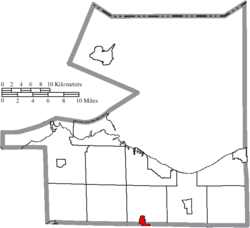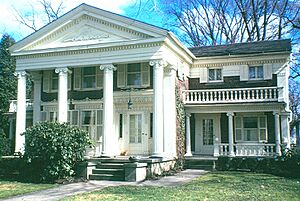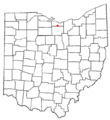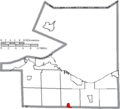Milan, Ohio facts for kids
Quick facts for kids
Milan, Ohio
|
|
|---|---|
|
Village
|
|

The Kelley Block overlooking the public square
|
|
| Nickname(s):
Edison
|
|

Location of Milan, Ohio
|
|

Location of Milan in Erie County
|
|
| Country | United States |
| State | Ohio |
| Counties | Erie, Huron |
| Townships | Norwalk, Milan |
| Area | |
| • Total | 1.21 sq mi (3.13 km2) |
| • Land | 1.19 sq mi (3.08 km2) |
| • Water | 0.02 sq mi (0.04 km2) |
| Elevation | 666 ft (203 m) |
| Population
(2020)
|
|
| • Total | 1,371 |
| • Density | 1,151.13/sq mi (444.56/km2) |
| Time zone | UTC-5 (Eastern (EST)) |
| • Summer (DST) | UTC-4 (EDT) |
| ZIP code |
44846
|
| Area code(s) | 419 |
| FIPS code | 39-50134 |
| GNIS feature ID | 2399341 |
Milan (pronounced MY-lən) is a small village located in Erie and Huron counties in the state of Ohio. In 2020, about 1,371 people lived here. Milan is most famous for being the birthplace and childhood home of the amazing inventor, Thomas Edison.
The part of Milan in Erie County is near the city of Sandusky. The part in Huron County is near Norwalk.
Contents
History and Culture: Milan's Past
Milan village was first planned out by Ebenezer Merry in 1817. It was built on the site of an older Native American village called "Petquotting." This village was used by the Moravian missionaries from 1805 to 1809.
Ebenezer Merry built a dam on the Huron River and set up "Merrys Mills." These mills included a gristmill (for grinding grain) and a sawmill (for cutting wood). Milan village was first called 'Beatty' but was renamed 'Milan' in 1833. It was named after the city of Milan, Italy.
Before railroads were common, farmers had to take their crops to Lake Erie ports using wagons. The land north and west of Milan was sandy and wet, making it hard for heavy wagons to cross. So, in 1826, people in Milan suggested building a canal to connect Milan directly to Lake Erie. This would link them to the new Erie Canal, allowing trade with New York City.
The Milan Canal: A Busy Port (1800s)
Building the Milan Canal started in 1833. It opened for boats on July 4, 1839. The busiest year for trade was 1847. For over 15 years, Milan was one of the busiest ports on the Great Lakes. Many wagons carrying farm products would line up for miles to the south, waiting to unload.
During this time, Milan became the birthplace of the famous businessman and inventor, Thomas Alva Edison. He was born on February 11, 1847. His small brick home is now a museum that you can visit. Thomas Edison lived in Milan until he was 7 years old. Then, his family moved to Port Huron, Michigan.
Local businesses in Milan traded farm goods from farmers for money, tools, and other items. These goods came from the East, across Lake Erie, through the Erie Canal. The Milan Canal was deep, letting large Lake Erie ships come right into Milan. This was different from other canals that needed smaller, shallow boats. Because of this deep canal, the rich farmland nearby, and the direct link to New York markets, Milan became a major trading center from the 1830s to the early 1850s.
However, when railroads became popular in the 1850s, the canal's success ended. In 1868, a flood damaged the canal's dam, stopping Milan's direct connection to the lake forever. Today, you can still see parts of the original canal route along the Erie MetroParks "Huron River Greenway."
The deep canal and harbor also made Milan a place where ships were built. This was because there were many white oak trees nearby, which were great for shipbuilding. About 60 ships were built in Milan between 1840 and 1867.
Milan's Historic Buildings and Architecture
The wealth from the canal era allowed many beautiful buildings to be constructed. Today, Milan still has many homes and businesses from the 1800s. These buildings show the typical architectural styles of that time.
In the late 1820s and 1830s, many buildings were built in the Federal Style. Many of these are still standing. In the 1840s and 1850s, the Greek Revival style was very popular in Milan. This style was also common in northeastern Ohio. Today, Milan's neighborhoods are full of original Greek Revival houses, along with other Victorian styles from later years.
Because of the growing number of railroads, people who owned canal businesses kept railroads from coming into Milan. This made the village somewhat isolated from the booming economy after the Civil War. As a result, Milan's growth mostly stopped in the 1850s and 1860s.
Today, most of the large canal-era mansions and other buildings are still in great shape. This makes Milan one of the best places to see 19th-century architecture in the Midwest. The Kelley Block on the village square and the impressive houses on all the streets are very well preserved. In 2002, Milan was chosen by The National Trust for Historic Preservation as a "Distinctive Destination."
Farmers in the area also grew a lot of melons because of the sandy, fertile soil. Milan celebrates this with the "Milan Melon Festival" every year on Labor Day weekend. Even though many people living in Milan now work in other cities, the area still feels very rural, agricultural, and historic. Because it didn't develop much after the canal closed, Milan still has the charm of a 19th-century village.
Geography: Where is Milan?
Milan is a small village. It covers about 1.21 square miles (3.13 square kilometers) in total. Most of this area is land, with a small amount of water.
The Huron River flows just north of the village square.
Population: Who Lives in Milan?
| Historical population | |||
|---|---|---|---|
| Census | Pop. | %± | |
| 1860 | 771 | — | |
| 1870 | 774 | 0.4% | |
| 1880 | 797 | 3.0% | |
| 1890 | 627 | −21.3% | |
| 1900 | 653 | 4.1% | |
| 1910 | 696 | 6.6% | |
| 1920 | 653 | −6.2% | |
| 1930 | 678 | 3.8% | |
| 1940 | 719 | 6.0% | |
| 1950 | 846 | 17.7% | |
| 1960 | 1,309 | 54.7% | |
| 1970 | 1,862 | 42.2% | |
| 1980 | 1,569 | −15.7% | |
| 1990 | 1,464 | −6.7% | |
| 2000 | 1,445 | −1.3% | |
| 2010 | 1,367 | −5.4% | |
| 2020 | 1,371 | 0.3% | |
| U.S. Decennial Census | |||
Milan's Population in 2010
In 2010, there were 1,367 people living in Milan. There were 509 households, and 370 of these were families. The village had about 1,149 people per square mile.
Most of the people living in Milan were White (97.5%). A small number were African American (0.7%), Native American (0.1%), or Asian (0.6%). About 1.8% of the population was Hispanic or Latino.
About 33.6% of households had children under 18 living with them. Most households (57.6%) were married couples. The average age of people in the village was 44.5 years old. About 23.6% of residents were under 18.
Education: Milan's Schools
Milan shares its school system with Berlin Heights. This combined district is called Edison Local Schools. The high school sports teams are known as the "Edison Chargers."
Edison High School offers college courses from Kenyon College and Findlay University. The school district includes Edison Elementary, Edison Middle School, and Edison High School.
Notable People from Milan
Many interesting people have come from Milan, Ohio:
- Augustus L. Armstrong, a lawyer and state legislator in Minnesota.
- Moses K. Armstrong, a businessman and legislator in Dakota Territory.
- Thomas H. Armstrong, a former Lieutenant Governor of Minnesota.
- Thomas J. Bowles, a former member of the Wisconsin State Assembly.
- Thomas Edison, the famous businessman and inventor.
- Daniel McBride Graham, a pastor and inventor, who was the first president of Hillsdale College.
Sister Cities: Milan's International Friendships
The village of Milan has one international sister city:
 Yawata, Kyoto (Japan)
Yawata, Kyoto (Japan)
Images for kids
See also
 In Spanish: Milan (Ohio) para niños
In Spanish: Milan (Ohio) para niños






